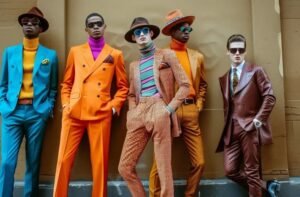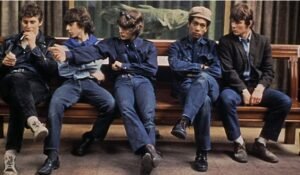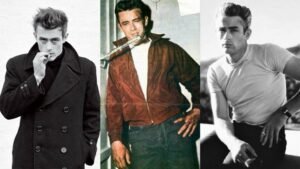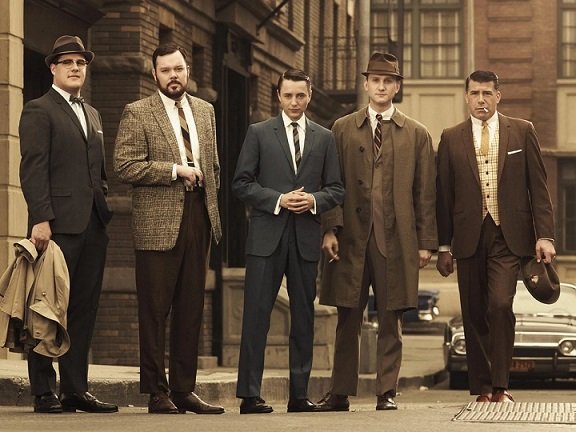Introduction to Men’s 1960s Fashion
The 1960s marked a defining moment in the evolution of men’s fashion. This was a time when traditional fashion boundaries were pushed aside, and bold new styles began to emerge that reflected a rapidly changing world. The decade saw the rise of youth culture, the impact of music, and political upheaval, all of which played a significant role in shaping the fashion trends of the time. In this article, we will explore the various key styles that defined men’s fashion during the 1960s and how each influenced the clothing choices of men today.
1. Overview of 1960s Men’s Fashion
The 1960s were a period of major social and cultural transformation. From the rise of the youth counterculture to the civil rights movement, the decade was one of innovation, experimentation, and breaking away from the past. In terms of fashion, men in the 1960s began to challenge traditional gender roles, looking to style icons and musicians as their fashion inspirations. While fashion in the 1950s was about refinement and formality, the 1960s was a time of rebellion and individualism.
As the decade progressed, fashion became more casual, with clothes reflecting a sense of freedom and self-expression. The youth-driven Mod movement, along with other subcultures, shaped the way men dressed. The emergence of psychedelic prints, tailored suits, and casual wear like T-shirts and jeans became the mainstay for young men across the world.
2. Influential Styles of the 1960s

Mod Style
One of the most iconic and influential fashion movements of the 1960s was the Mod (short for “modernist”) style. This movement, which originated in London, was characterized by sharp, clean lines and a youthful energy. The Mods were known for their stylish, tailored suits, skinny ties, and sleek, geometric patterns. Bright colors, bold prints, and a focus on fashion-forward accessories like sleek boots and slim-fit trousers made Mod style a symbol of youthful rebellion and cool sophistication.
Key Features of Mod Style:
- Slim Fit Suits: Often with narrow lapels, usually worn with a skinny tie.
- Bold Patterns: Geometric prints, stripes, and checks were common.
- Pointed Shoes: Pointed-toe shoes or boots, often in leather or suede.
- Accessories: Turtlenecks, scarves, and the iconic parka coat.
The Rocker Look
The Rocker look was heavily influenced by the burgeoning rock and roll culture of the 1960s. With the rise of bands like The Rolling Stones and The Who, young men began adopting a style that was grittier and more rebellious than the polished Mod look. The rocker style was all about attitude, with leather jackets, motorcycle boots, and faded denim becoming the hallmark of the look. Rockers embraced a more rugged and raw aesthetic, inspired by the rebellious figures of the time.
Key Features of the Rocker Look:
- Leather Jackets: Black leather or biker-style jackets were a must.
- Faded Denim: Distressed or ripped denim jeans and jackets.
- Boots: Heavy-duty leather boots, often worn with tight jeans.
- T-shirts: Plain or graphic tees, worn under jackets or on their own.
The Hippie Movement
While the Mod and Rocker looks represented a certain level of sophistication or rebellion, the Hippie movement was all about peace, love, and freedom. As the decade progressed, young people in the United States and around the world began embracing a bohemian style characterized by loose-fitting clothing, ethnic prints, and natural materials. For men, this meant flowing shirts, wide-legged pants, fringe jackets, and beaded accessories.
Key Features of the Hippie Look:
- Bell-Bottoms: Flared trousers, often with intricate embroidery or patches.
- Tie-Dye and Floral Prints: Vibrant patterns were a central theme.
- Loose Shirts and Tunics: Often made from natural materials like cotton or hemp.
- Headbands and Beads: Accessories that emphasized the laid-back, carefree vibe.
Ivy League and Preppy Style
The Ivy League look emerged from the prestigious universities of the northeastern United States. It was a preppy style that combined elements of traditional, classic American fashion with a youthful and collegiate flair. This look was marked by clean-cut tailoring, casual but polished pieces, and a color palette of navy, white, and pastels.
Key Features of Ivy League Style:
- Tweed Blazers: Often paired with chinos or dress trousers.
- Polo Shirts: A key casual item for any Ivy League wardrobe.
- Cardigans and Vests: Layered under jackets or over shirts for a smart-casual look.
- Loafers: Leather loafers or moccasins were common footwear.
3. Fabric and Color Trends
Fabrics of the 1960s
The 1960s saw the rise of a wide variety of fabrics that were not only stylish but practical. Some of the most popular fabrics included:
- Wool: Used extensively for suits, blazers, and trousers.
- Tweed: A rugged, yet sophisticated fabric, often seen in Ivy League and preppy styles.
- Corduroy: A textured fabric that gained popularity for both trousers and jackets.
- Polyester: Synthetic fabrics started gaining traction as affordable, low-maintenance alternatives to natural fibers.
Color Trends
1960s men’s fashion was characterized by vibrant colors and bold patterns. While traditional colors like navy, black, and gray remained popular for formal wear, younger men embraced brighter hues like teal, mustard yellow, and orange. Bold patterns such as stripes, checks, and paisley were also common in the fashion scene.
4. Famous Figures and Icons Who Shaped 1960s Fashion

The 1960s were a time when cultural icons wielded immense influence over fashion. Here are some of the key figures who helped shape the men’s fashion scene of the decade:
The Beatles
The Beatles were not just a groundbreaking musical act, but their style also became iconic. Their early look was all about the mod aesthetic, with sharp suits, mop-top haircuts, and skinny ties. As the band’s sound evolved, so did their fashion, moving from the clean-cut Mod look to a more eclectic and bohemian style, particularly as they embraced the hippie movement in the later years of the decade.
James Dean
Although James Dean passed away in 1955, his style continued to influence men’s fashion throughout the 1960s. Dean’s iconic leather jacket, plain T-shirt, and jeans look became the epitome of cool, rebellious style. His image was adopted by young men as the ideal of casual yet edgy fashion.
Steve McQueen
Steve McQueen, known for his roles in films like Bullitt, became a style icon in the 1960s. His athletic, rugged look often included classic pieces like aviator sunglasses, leather jackets, and turtlenecks, making him a style model for men who wanted to project an aura of coolness and confidence.
5. 1960s Fashion in Popular Culture
Cinema Influence
The 1960s saw a major transformation in cinema, with films like The Graduate and Easy Rider influencing the fashion choices of young men. Characters in these films often wore tailored suits, denim jackets, and other garments that reflected the changing attitudes toward fashion. The popularity of these films ensured that the styles featured on screen quickly became mainstream.
Music and Fashion Intersection
The link between music and fashion in the 1960s was undeniable. Musicians like The Beatles, The Rolling Stones, and Bob Dylan not only revolutionized music but also introduced new fashion trends to their audiences. The Mod look, for example, was closely tied to the British Invasion, with bands like The Who and The Kinks leading the way in terms of fashion.
6. Key Accessories and Shoes

Accessories
- Sunglasses: The iconic aviator sunglasses became widely popular, especially due to their association with stars like Steve McQueen.
- Scarves: Both functional and stylish, scarves were often worn around the neck or tied to bags.
- Hats: From bowlers to wide-brimmed fedoras, hats were a staple accessory for many men during the 1960s.
Shoes
- Chelsea Boots: These ankle-length boots became a symbol of 1960s fashion, popularized by The Beatles.
- Loafers: These slip-on shoes were a versatile, stylish option that worked for both casual and semi-formal wear.
- Boots: Leather and suede boots became synonymous with the Rocker and Hippie looks.
7. Evolution of Tailoring in the 1960s
The 1960s saw a move away from the more conservative, boxy suits of previous decades. Tailoring became more slender and streamlined, with slimmer lapels and trousers that created a more modern, youthful silhouette. The rise of the Mod look also played a huge role in shaping how men’s suits were cut and styled, making it clear that the old-fashioned approach to tailoring was no longer in vogue.
8. The Legacy of 1960s Men’s Fashion
The 1960s had a lasting impact on fashion. Many of the trends that emerged during the decade, such as slim suits, casual denim, and bohemian style, are still evident in today’s fashion landscape. The rebellion and freedom of the 1960s continue to inspire designers, musicians, and style icons to push boundaries and redefine what it means to dress well.
9. Conclusion
Men’s 1960s fashion was all about breaking from tradition, embracing youthful energy, and experimenting with new styles. From the sharp Mod suits to the casual, free-spirited looks of the Hippie movement, the decade was marked by innovation, rebellion, and the influence of music and culture. Today, elements of 1960s fashion continue to influence menswear, ensuring that the legacy of this iconic decade remains alive and well in modern fashion.
Important Information About Men’s 1960s Fashion
| Key Trend/Influence | Description | Famous Figures | Style Characteristics |
|---|---|---|---|
| Mod Style | Sharp, tailored suits with skinny ties and clean lines. | The Beatles, The Kinks | Slim fit suits, geometric patterns, pointed shoes. |
| Rocker Look | Leather jackets, denim, and rebellious attitudes. | The Rolling Stones, Jimmy Hendrix | Faded denim, T-shirts, boots, edgy appearance. |
| Hippie Movement | Relaxed, bohemian fashion, with ethnic prints and loose clothing. | Bob Dylan, Jim Morrison | Bell-bottoms, tie-dye, fringe jackets, beads. |
| Ivy League/Preppy | Classic American college look with clean-cut clothing. | John F. Kennedy | Tweed blazers, polos, chinos, loafers. |
By the end of the 1960s, fashion had undergone a massive transformation, one that still resonates in today’s trends. Understanding the influences and subcultures that shaped the period offers valuable insights into how fashion continues to evolve and reflect societal changes. Whether you’re a fan of the mod aesthetic or a rocker at heart, the fashion of the 1960s has something for everyone, even half a century later.
